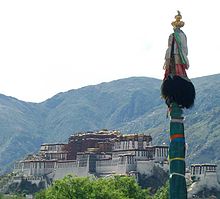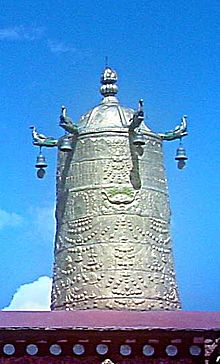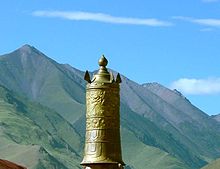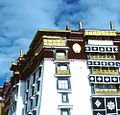- Dhvaja
-
Dhvaja (Skt. also Dhwaja; Tibetan: རྒྱལ་མཚན, Wylie: rgyal-msthan), meaning banner or flag. The Dhvaja is comprised amongst the Ashtamangala, the 'eight auspicious symbols'.
Contents
In Hinduism
Dhvaja in the Brahmanic cults, takes on the appearance of a high column (dhvaja-stambha) erected in front of temples.
Dhvaja, meaning a Flag banner, was a military standard of ancient Indian warfare.
Tibetan architecture
Within the Tibetan tradition a list of eleven different forms of the victory banner is given to represent eleven specific methods for overcoming 'defilements' (Sanskrit: klesha). Many variations of the dhvaja's design can be seen on the roofs of Tibetan 'monasteries' (Gompa, Vihara) to symbolyze the Buddha's victory over four maras. In its most traditional form the victory banner is fashioned as a cylindrical ensign mounted upon long wooden axel-pole. The top of the banner takes the form of a small white 'parasol' (Sanskrit: chhatra), which is surrounded by a central 'wish granting gem' (Sanskrit: cintamani). This domed parasol is rimmed by an ornate golden crest-bar or moon-crest with makara-trailed ends, from which hangs a billowing yellow or 'white silk scarf' (Sanskrit: khata) (see top right). As a hand held ensign the victory banner is an attribute of many deities, particularly those associated with wealth and power, such as Vaiśravaṇa, the Great Guardian King of the north. As roof-mounted ensign the victory banners are cylinders usually made of beaten copper (technique similar to Toreutics) and are traditionally placed on the four corners of monastery and temple roofs. Those roof ornaments usually take the form of a small circular parasol surmounted by the wish-fulfilling gem, with four or eight makara heads at the parasol edge, supporting little silver bells (see the Jokhang Dhvaja on the left). A smaller victory banner fashioned on a beaten copper frame, hung with black silk, and surmounted by a flaming 'trident' (Sanskrit: trishula) is also commonly displayed on the roofs (see the Dhvaja on the roof of the Potala Palace below).[1][2].
-
Dhvaja (Victory banner) - trident design with black silk, roof of the Potala Palace.
-
Dhvaja (Victory banner), Roof of Potala Palace.
See also
References
Categories:- Buddhist ritual implements
- Buddhist symbols
- Ritual weapons
- Tibetan Buddhist practices
Wikimedia Foundation. 2010.






